
Pairing ideas with libertias
How to combine libertias for a natural or theatrical effect?
Contents
Libertia is an evergreen perennial belonging to the genus Iridaceae. A cousin of the southern hemisphere’s garden irises, it lacks the large rhizomes at the base of the leaves and resembles a carex more closely. The majority of libertias, native to New Zealand and a few from Chile, form beautiful upright clumps adorned with grass-like foliage, topped in spring by delicate white flowers. Imagine a plant that is beautiful all year round, with stunning colours and even more graceful in the winter frost. On top of that, add original flowers. These New Zealand irises, the libertias, meet all your expectations regardless of your garden style, whether Japanese, aquatic, natural, or modern…
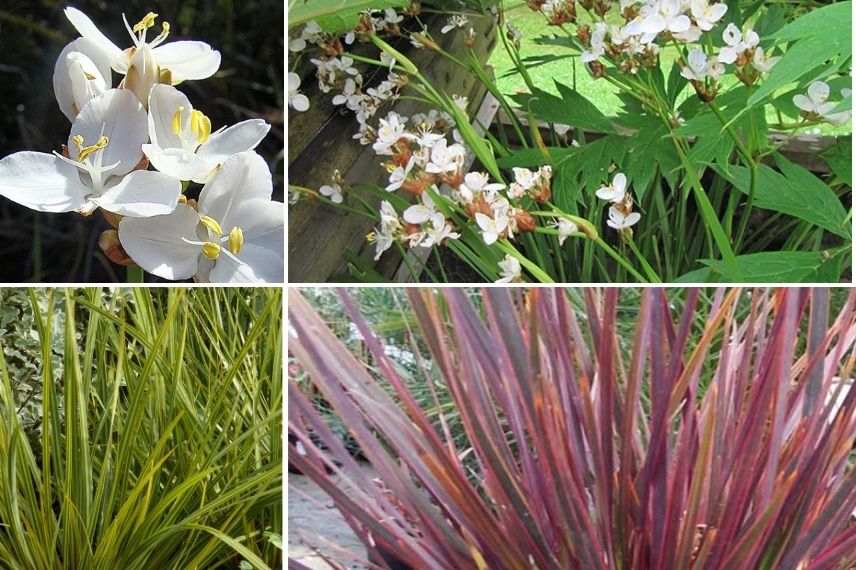
Iridaceae with grass-like foliage, libertias are very easy to acclimatise in any region that is not too cold.
Successful graphic effect by the water
The Libertia grandiflora is a plant with a graceful and supple habit that will look stunning near a water feature. Its generous white flowering is spectacular amidst the soft pink spikes of the knotweed Polygonum bistorta ‘Superbum’.
- Right at the water’s edge, Butomus umbellatus, is a paludal perennial of shallow waters. Its clumps of stiff stems are topped with fragrant umbels of flowers in shades of white, pink, and red. It adds a whimsical touch to aquatic scenes in summer.
- The Zantedeschia aethiopica ‘Pink Flamingo’ has pink buds that open into large soft pink trumpets on the outside and white on the inside. They appear in spring and summer above its glossy dark green foliage.
- The Iris laevigata, known as Japanese water iris, is another botanical species of marshy medium that forms beautiful flowering masses of blue-violet to soft pink in spring for the variety ‘Queen Victoria’.
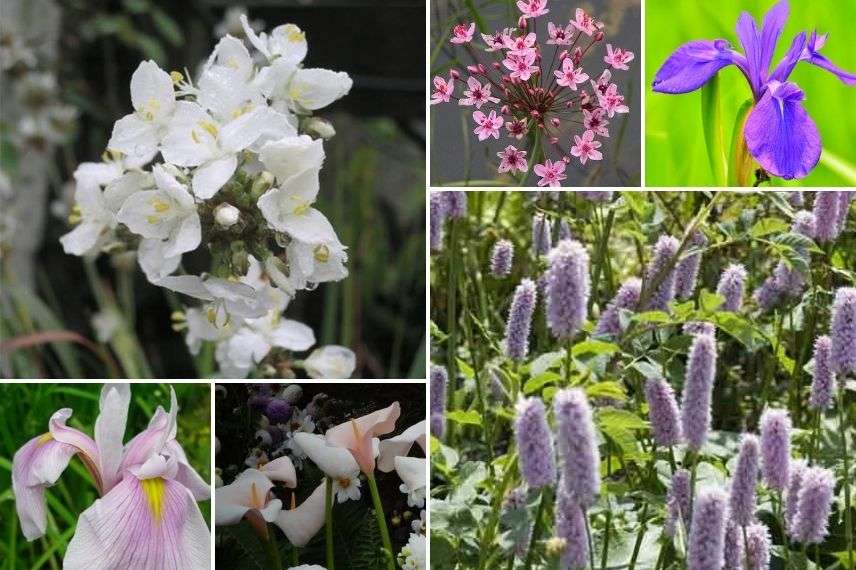
White flowering of Libertia grandiflora; at the top right, the graceful rush Butomus and the soft pink spikes of the knotweed; on the left, a symphony of porcelain pink from the ‘Pink Flamingo’ arum and the ‘Queen Victoria’ iris.
Read also
Libertia: planting, growingIn a Japanese-style garden
Create a Japanese-inspired scene in a quiet, sheltered spot in your garden or in a container in your courtyard to enjoy it from your windows as well. Delight in the spectacle of the generous flowering of the Libertia sessiliflora caerulescens and the beauty of its spring flowering, with dense panicles of pale mauve flowers enhanced by orange stamens. Position them in front of a bushy veronica also native to New Zealand, Hebe ‘Celebration’ with magenta pink flowers. To make the scene even more floral and spectacular, install a carpet of Japanese primroses Primula japonica ‘Apple Blossom’ with apple blossom flowers bearing crowns of soft pink tubular flowers with coral red centres. Enhance the exotic touch with Michelia, a beautiful bush with evergreen green foliage and cup-shaped flowers resembling slightly fragrant magnolias. No Japanese scene is complete without the flowering of a Prunus ‘Accolade’, a symbol of beauty and the fragility of existence. The flowering of cherry trees marks the long-awaited renewal of spring. Every year, as tradition dictates, it’s time for hanami, an ancient practice of sitting on beautiful blankets, drinking sake, and contemplating the beauty that Nature has to offer. An ephemeral beauty with spiritual significance.This scene would be perfect by the sea in Brittany.
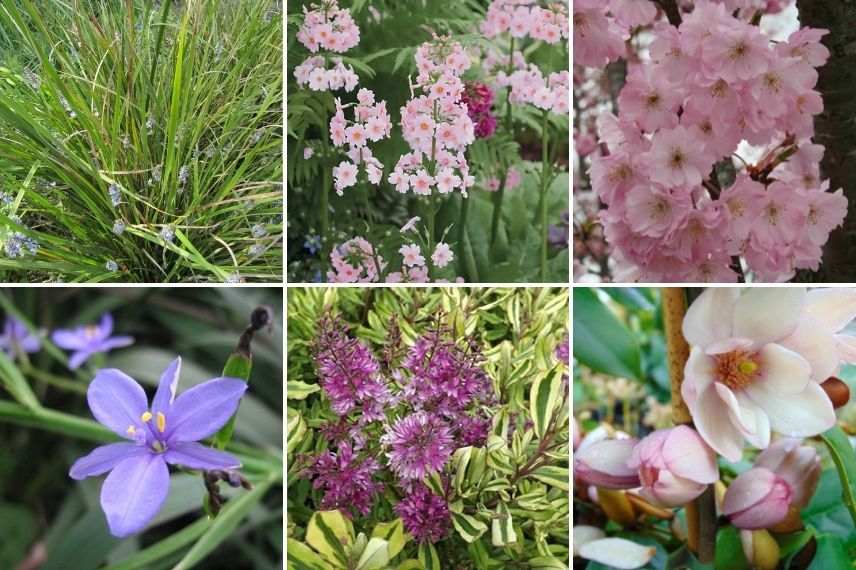
On the left, Libertia with blue flowers; in the centre, Japanese primroses (top) and Hebe ‘Celebration’; on the right, flowering of Prunus ‘Accolade’ (top) and Michelia (bottom)
Discover other Libertia
View all →Available in 2 sizes
Available in 1 sizes
Available in 1 sizes
Available in 1 sizes
Available in 1 sizes
Available in 1 sizes
Available in 2 sizes
Available in 2 sizes
In a late summer border
Nestled among the heathers Calluna vulgaris ‘Allegro’, the long upright stems of Libertia ixioides ‘Taupo sunset’ with their vibrant colours appear translucent backlit. They offer an unreal spectacle as the delicate white stars of its flowering gracefully intermingle. The large early ornamental grasses of Calamagrostis acutiflora ‘Avalanche’ form opulent clumps, composed of fine dense foliage, grey-green adorned with a central white band. The inflorescences appear in late summer, well above the foliage, in the form of narrow plumes of purple mauve, turning blonde over time. The Leucothoe fontanesiana ‘Whitewater’, a beautiful evergreen bush, will surprise you with every change of season through its foliage, branches, and flowering in multiple colours. Indeed, this bush is also called pearl flower for its pearly white flowering at the end of the branch. It will reach 1.20 m in height and 1 m in spread at maturity. Its evergreen leaves are dark green, marginate with cream white in summer. During winter, its leaves take on a purplish hue, and in spring the new leaves emerge under a bronze robe. This variety will also charm you with its purple branches contrasting in summer with its light foliage. The flowering of libertia composed of large flowers in white to cream will be highlighted by the incessant flowering for several months of the Japanese anemones Anemone hupehensis ‘September Charm’.
 On the left, Libertia ixioides ‘Taupo sunset’. In the centre, the Leucothoe with cream-margined leaves, and the heathers Calluna ‘Allegro’ in bloom (below). On the right, Calamagrostis (above) and Japanese anemones ‘September Charm’
On the left, Libertia ixioides ‘Taupo sunset’. In the centre, the Leucothoe with cream-margined leaves, and the heathers Calluna ‘Allegro’ in bloom (below). On the right, Calamagrostis (above) and Japanese anemones ‘September Charm’
In a gravel garden
The Libertia ixioides ‘Goldfinger’ was created in 2002 for its golden yellow foliage and its abundant flowering of small white stars in spring, followed by golden yellow berries. It will fit perfectly alongside the Ipheion uniflorum ‘White Star’. The delicately scented white flowers of this small bulb provide a very long spring flowering period, lasting at least 3 months, from February-March to May. This small bulbous plant naturalises quickly in the garden. The Oregon Stonecrop Sedum oreganum, with its lovely miniature foliage, will carpet the free spaces in the border. Evergreen, its colour changes from green to red, providing a changing decoration throughout the seasons. Ideal for sunny rockeries, this perennial groundcover attracts butterflies in July with its yellow star-shaped flowers. Hardy and low-maintenance, the Antennaria dioica ‘Rubra’ is a small, hardy, mat-forming perennial of montane origin, with beautiful woolly, silver evergreen foliage that adds a whimsical touch with the flowering of its small, intense purplish-red capitula flowers.
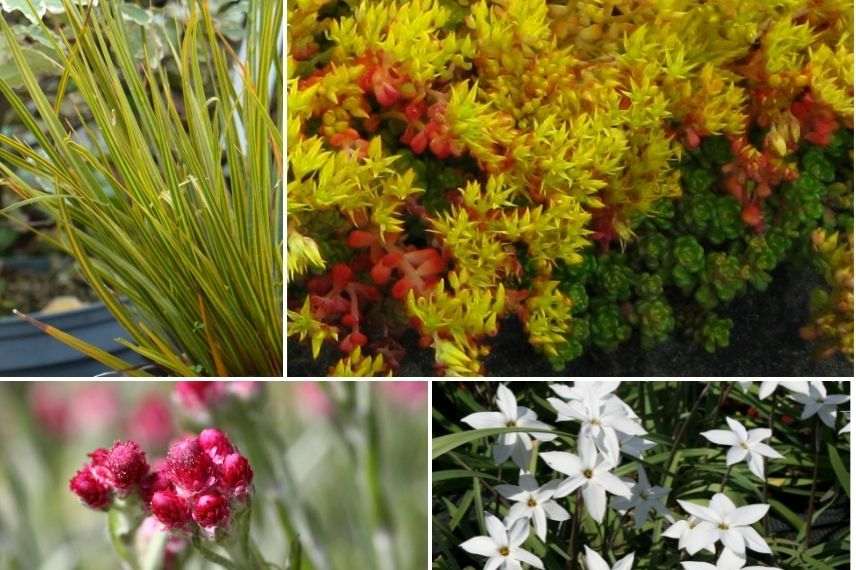
The warm colours of Libertia ‘Goldfinger’ harmonise perfectly with the golden yellow Sedum oreganum. The ruby red flowering of Antennaria shines amidst the starry carpet of Iphéion that heralds spring.
In a bright winter border
Libertia peregrinans is a bush with evergreen foliage in winter. Its yellow-orange colour makes it the perfect backdrop for two beautiful hellebores: Hellebore x sternii ‘Boughton Beauty’, chosen for its green foliage with metallic slate grey highlights; its flowers are violet-pink on the outside and pale yellow on the inside. The Hellebore sternii ‘Grey Star’ features upright stems that bear the foliage and flowers. They are pale pink in bud and then open to cream-green. Its marbled silver and pale green foliage is very decorative. These two beautiful hellebores bloom in winter from December to April.
In the flower bed, plant a carpet of periwinkle Vinca minor ‘Illumination’. This stunning little periwinkle with a trailing habit develops long, flexible stems covered with small, variegated evergreen leaves that are light yellow and marginate with green. It blooms abundantly in spring, with small blue stars.
The Cornus sericea or stolonifera ‘Cardinal’ adds a fantastic touch of raspberry red with the beauty of its bark. Stunning as a specimen or in a mix, this bush will be the ideal companion plant for our golden Libertia.
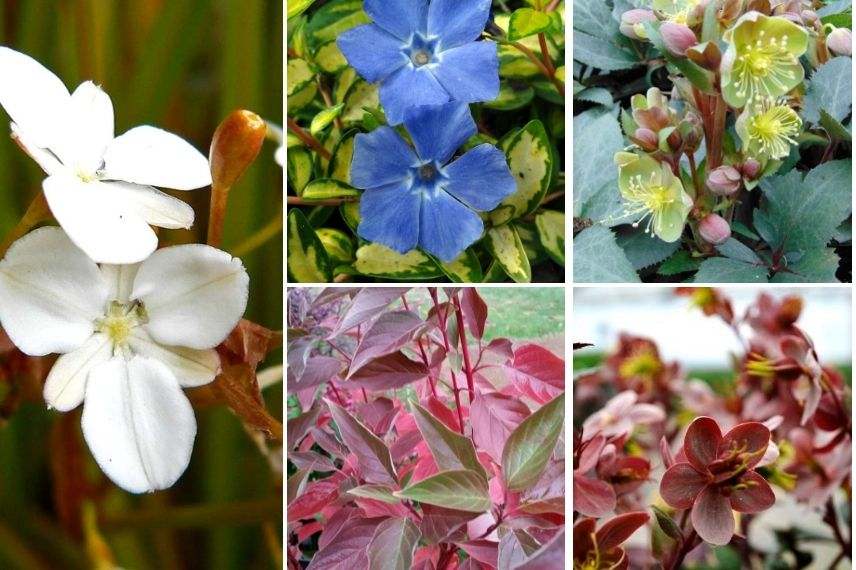
In mid-winter, the pearly flowering of Libertia peregrinans with its orange foliage emerges from a bicoloured carpet of the small periwinkle mixed with the flowering of the hellebores.
In a white garden
Nothing is more elegant than a white garden. The Libertia formosa and its delicately white flowering will be paired with a carpet of dye chamomile Anthemis tinctoria ‘Sauce Hollandaise’. This very floriferous perennial with solitary buttery yellow almost white flowers blooms all summer long. Nicknamed “Beef Eye”, it forms a hardy bushy clump with excellent durability. This anthémis ‘Sauce Hollandaise’ has light green foliage and an abundant flowering of cream daisies with yellow centres. In spring, the flowering of the large candelabra of Sisyrinchium striatum with cream-white flowers is followed in summer by the emergence of Japanese anemones ‘Whirlwind’ with multiple white flowers veined with pink on the reverse. Light and airy, they sway gently in the wind and play hide and seek with the sun. One can pair them with the extravagant Echinacea purpurea ‘Ferris Wheels’ and Echinacea purpurea ‘White Swan’ in the middle of the bed.

On the left, Libertia formosa and Sisyrinchium; in the centre, Echinacea ‘White Swan’ and ‘Ferris Wheels’; on the right, Japanese anemone and chamomile ‘Sauce Hollandaise’
For a theatrical effect in this scene, invite the Eremurus ‘White Beauty Favourite’, also known as Ruiters hybrid steppe lily. It offers in late spring or early summer immense spikes of surprising lightness despite their imposing size, covered with hundreds of small ivory-white star-shaped flowers, with yellow centres and stamens, emerging from a tuft of ribbon-like foliage.
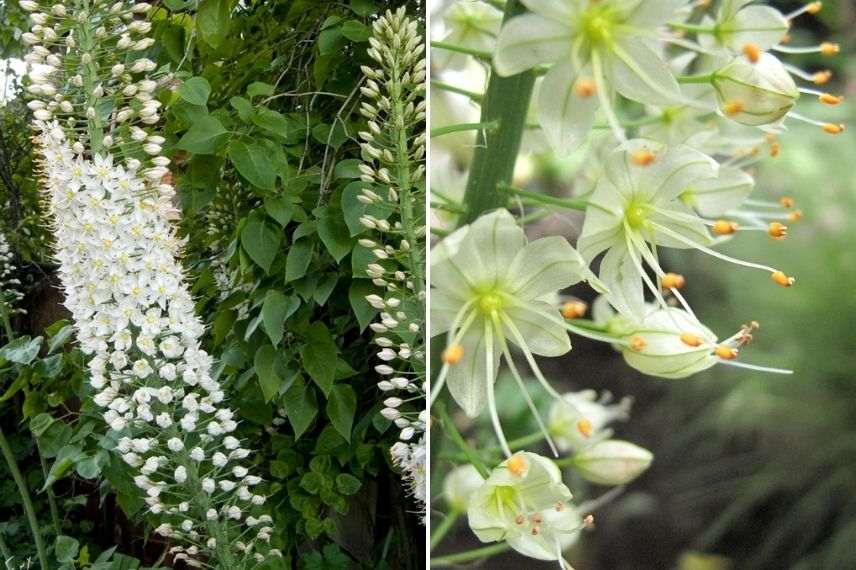
The Eremurus ‘White Beauty Favourite’
- Subscribe!
- Contents
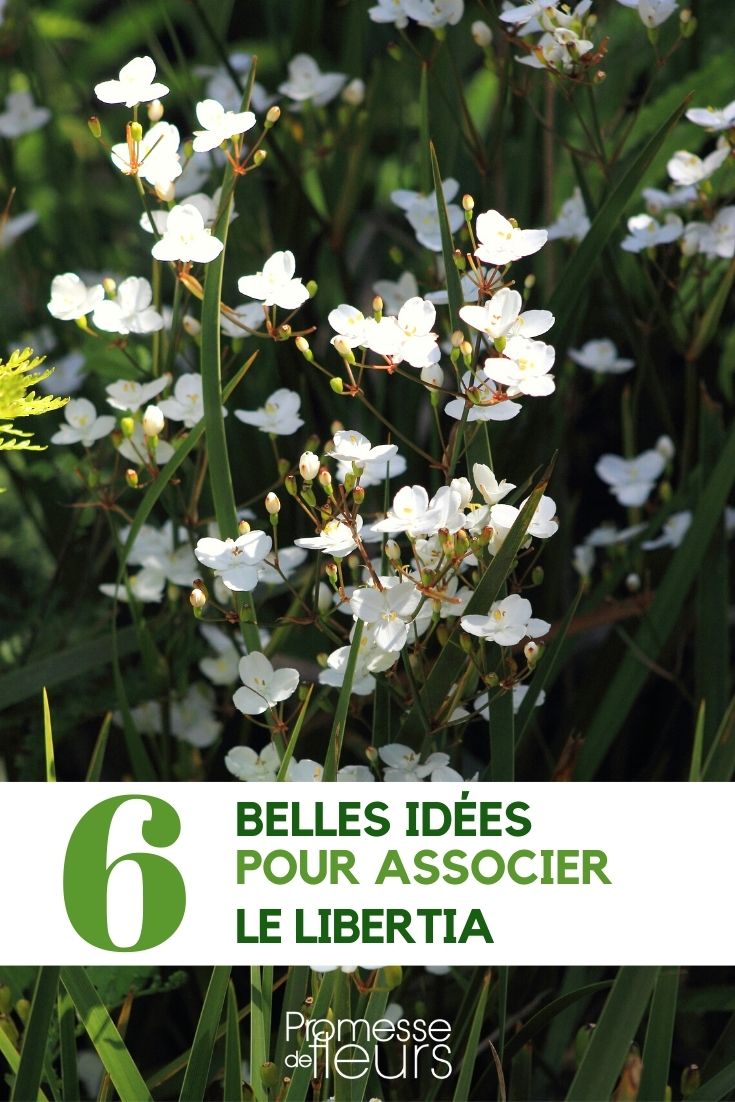































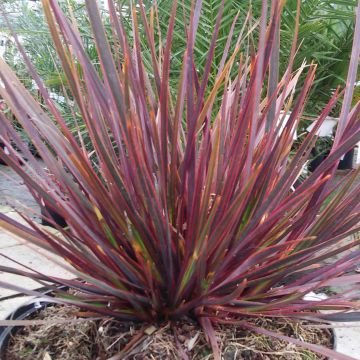
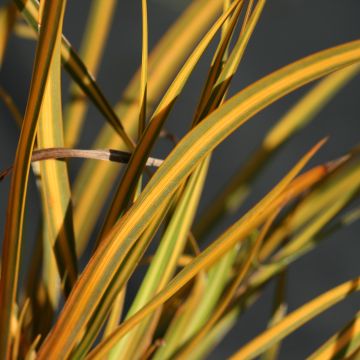

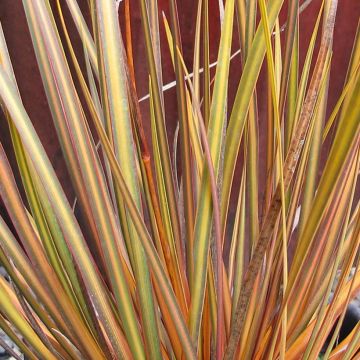
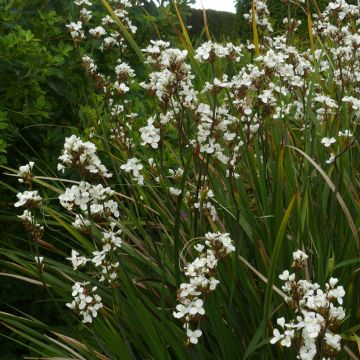
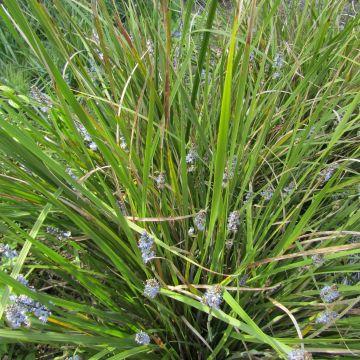
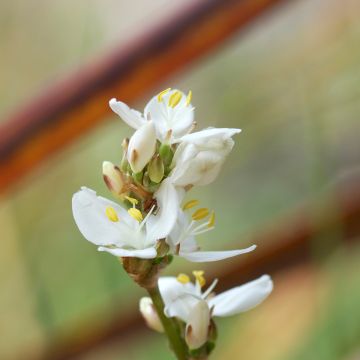
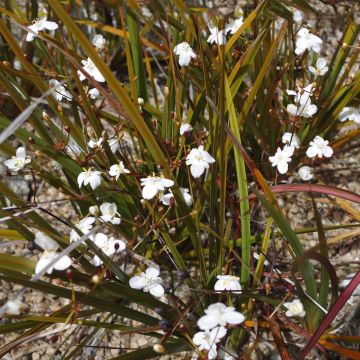
Comments